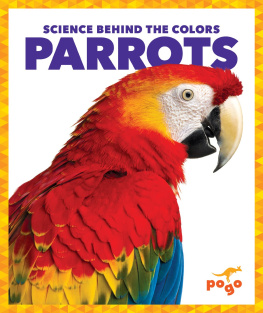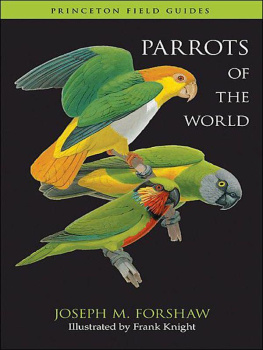Contents
Guide
Page List

NATURALIZED
Parrotsof
theWorld
NATURALIZED
Parrotsof
theWorld
Distribution, Ecology, and Impacts of
the Worlds Most Colorful Colonizers
Edited by Stephen Pruett-Jones
Princeton University Press
Princeton and Oxford
Copyright 2021 by Princeton University Press
Princeton University Press is committed to the protection of copyright and the intellectual property our authors entrust to us. Copyright promotes the progress and integrity of knowledge. Thank you for supporting free speech and the global exchange of ideas by purchasing an authorized edition of this book. If you wish to reproduce or distribute any part of it in any form, please obtain permission.
Requests for permission to reproduce material from this work should be sent to
Published by Princeton University Press
41 William Street, Princeton, New Jersey 08540
6 Oxford Street, Woodstock, Oxfordshire OX20 1TR
press.princeton.edu
All Rights Reserved
Library of Congress Cataloging-in-Publication Data
Names: Pruett-Jones, Stephen, editor.
Title: Naturalized parrots of the world : distribution, ecology, and impacts of the worlds most colorful colonizers / edited by Stephen Pruett-Jones.
Description: Princeton : Princeton University Press, [2021] | Includes bibliographical references and index.
Identifiers: LCCN 2020045356 (print) | LCCN 2020045357 (ebook) | ISBN 9780691204413 (hardback) | ISBN 9780691220710 (ebook)
Version 1.0
Subjects: LCSH: Parrots. | ParrotsColonizationCase studies. | Introduced birdsCase studies.
Classification: LCC SF473.P3 N38 2021 (print) | LCC SF473.P3 (ebook) | DDC 636.6/865--dc23
LC record available at https://lccn.loc.gov/2020045356
LC ebook record available at https://lccn.loc.gov/2020045357
British Library Cataloging-in-Publication Data is available
Editorial: Robert Kirk and Abigail Johnson
Production Editorial: Ellen Foos
Jacket Design: Wanda Espana
Production: Steven Sears
Publicity: Matthew Taylor and Caitlyn Robson
Copyeditor: Amy K. Hughes
Typset and design: D & N Publishing, Wiltshire, UK
Front cover image: Rose-ringed Parakeet (Psittacula krameri) in Yala National Park, Sri Lanka. Photo by Dave Stamboulis / Alamy Stock Photo. Back cover image: Monk Parakeets (Myiopsitta monachus) enjoying water from a birdbath, Port Salerno, Florida USA, May 2019. Photo by Jon-Mark Davey
This book has been composed in Avenir Book and Objectiv
CONTENTS
Laura Cardador, Pedro Abelln, Jos D. Anadn, Martina Carrete, and Jos L. Tella
Kay Royle and Wayne B. Donner
Sarah L. Crowley
Michael A. Russello, Grace Smith-Vidaurre, and Timothy F. Wright
Simon Kiacz and Donald J. Brightsmith
Emiliano Mori and Mattia Menchetti
Juan Carlos Senar, Michael Conroy, and Toms Montalvo
Enrique H. Bucher
Donald J. Brightsmith and Simon Kiacz
Hazel A. Jackson
Carlos E. Calzada Preston, Stephen Pruett-Jones, and Jessica R. Eberhard
Jennifer J. Uehling, Jason Tallant, and Stephen Pruett-Jones
Eric A. VanderWerf and Nicholas P. Kalodimos
Michael P. Braun
Martina Carrete, Pedro Abelln, Laura Cardador, Jos D. Anadn, and Jos L. Tella
Christopher J. Butler
Craig T. Symes, Ielyzaveta M. Ivanova, Caroline G. Howes, and Rowan O. Martin
Andrew M. Rogers and Salit Kark
Stephen Pruett-Jones
PREFACE
As a group, parrots are among the most endangered birds in the world. A number of species have already been driven to extinction, and many species are very close to that point. Originally, the major threat to wild parrots was humans shooting or trapping the birds for the millinery trade and/or as a result of real or perceived threats to agriculture. Within the last hundred years, however, and although parrots are still killed as a result of threats to agriculture, the greater concern has become and remains habitat loss or modification and legal or illegal trapping for the pet trade. The pet trade has contributed to population declines of many species, but it has also ironically led to the inadvertent introduction of parrots in novel geographical regions and habitats. The transport and introduction of non-native species of plants and animals is a widespread phenomenon involving thousands of species. In the case of parrots, approximately three-quarters of all species have been exported to new countries through the pet trade.
In some instances, parrots held as pets escape captivity or are purposefully released into the wild. If the habitat or climate regime is inhospitable, escaped or released parrots survive for a short period or season but then perish. However, if the habitat is suitable, parrots are quite capable of surviving in novel regions and habitats, as are many species. If the novel population increases in numbers, and reproduction is sufficient to maintain the population size, a self-sustaining population can be established. Parrots have been remarkably successful at adapting themselves to new and novel environments in introduced ranges. This is almost certainly the result of their behavioral flexibility, cognitive abilities that rival those of some primates, and high degree of sociality. Given the worldwide distribution of naturalized parrots, the increasing and expanding population sizes of some species, and escalating conflict with humans in some areas, it seemed appropriate to attempt a summary of the major issues surrounding naturalized parrots. That is the focus of this book: Naturalized Parrots of the World: Distribution, Ecology, and Impacts of the Worlds Most Colorful Colonizers.
Although different terminology can be found in different publications, in this book the authors refer to naturalized parrots as species that have been introduced to a novel area and have established self-sustaining breeding populations. The terms established and naturalized are thus used interchangeably here. Although not all authors discuss the impacts of introduced parrots, those that do will use the term invasive where the data suggest that a species is having a negative impact on native species, ecosystems, agricultural activities, or other economic activities (e.g., electrical transmission).
This book is divided into two parts, Part I, Background and Ecology; and Part II, Case Studies. The chapters in Part I deal with issues related to all introduced and naturalized parrots, and those in Part II deal with specific species or the community of parrots in individual geographic regions. The two species that have their own case studies are the Rose-ringed Parakeet (Psittacula krameri) and the Monk Parakeet (Myiopsitta monachus). The most widely distributed and abundant of the naturalized parrots in the world, these two species highlight the relevant social and ecological issues surrounding introduced parrots.
This book builds upon the work, both professional and volunteer, of hundreds of people worldwide whose efforts focus on the conservation of wild parrots and censuses of introduced species. Additionally, without the observations available in online databases from citizen science efforts, the chapters in this book would not have been possible. I wish to thank everyone who contributes to such databases. Additionally, I wish to thank each of the authors contributing to this book; my family and friends for support; and my graduate adviser, Dr. Clayton M. White, for giving me my first opportunity to see parrots in the wild.










